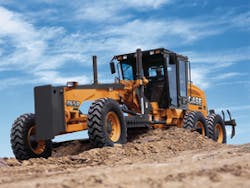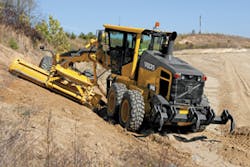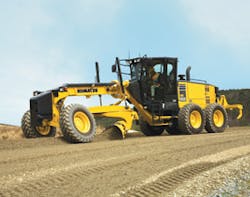Engineers for the major grader manufacturers have been hard at work lately. They have upgraded engines to Tier 4 Interim compliance. They have improved visibility and controls. Each company has optimized the weight, balance, and stability of the machine.
John Deere, for example, has redesigned its G-Series graders to include an Interim-Tier-4-certified engine and the industry’s only choice between console-mounted or armrest-mounted industry standard fingertip controls.
There are 12 G-Series models, ranging from 195 to 283 net horsepower. Six of the units feature six-wheel drive. That feature gives operators increased traction, the ability to get more work done in fewer blading passes and a 30% increase in blade pull.
As one of many contractors that were part of Deere’s long joint product development process, grader customer Jerry Pate had a definite idea what kind of controls he wanted. “If you’re going to go with electro-hydraulic controls, don’t put them in the old “˜antler rack’ position,” Pate says. “Put them where guys want them-in the armrest but in the same familiar pattern. Now you can run this machine nine to 10 hours a day and you don’t get fatigued. You’re not reaching out. It’s almost like sitting in a recliner or an easy chair because you’re in a natural position.”
“With the G-Series, it’s not “˜one size fits all’-you’re free to choose the control style that makes you the most comfortable and productive,” says Kent Stickler, product marketing manager for motor graders, John Deere Construction & Forestry. “And every grader has a steering wheel, no matter which control system you pick.”
Another customer need that Deere has built into the G-Series is the new Interim-Tier-4-certified engine. For maximum uptime, diesel particulate filter cleaning occurs during normal operation, without requiring action by the operator. The engine also has a new stall-prevention system that senses when the engine is going to stall, then automatically shifts the transmission to neutral. This saves wear and tear on the engine, which prolongs engine life and boosts uptime.
With Deere’s G-Series graders, operators continue to get a steering wheel and can choose from the console-mounted control pattern (G models) or intuitive and easy-to-use armrest-mounted fingertip controls (GP models). If an operator specifies the fingertip controls, he’ll still have a choice between using lever steering and the ever-present steering wheel. Either way, G-Series controls provide a smooth, predictable response and plenty of power whether the application calls for heavy blading or fine grading.
All John Deere G-Series Grade Pro units are grade-control ready. These machines can accept Trimble or Topcon grade-control systems, whichever the customer prefers. Customers asked Deere to integrate grade control buttons into the knobs of the control levers, making the system comfortable to use and easy to run. As a result, operators can keep their hands on the blade controls for higher productivity.
Better balance helps Volvo’s G900B achieve higher productivity.
Case’s New B Series
The B Series motor grader line from Case Construction Equipment includes all-wheel-drive (AWD) versions of the 885B and 865B motor graders, as well as the Case 845B and 885B dual-horsepower models.
Case says AWD provides more versatility to handle a greater variety of applications and working conditions. It delivers better traction, steering and side-draft control in wet and muddy conditions, and in applications requiring heavy blading for cutting, moving and mixing material.
Case B Series motor graders all feature an industry-exclusive front-articulation design and a multiradius, involute moldboard. “Front articulation allows for a tight turning radius that works well for cul-de-sacs and tight job sites. The cab is mounted further back on the machine, which gives the operator a commanding view of the complete moldboard, circle, saddle and tires,” says Paul Wade, brand marketing manager, Case Construction Equipment.
According to Case, the reinforced, involute moldboard enables the Case B Series motor graders to move more material with less horsepower and less fuel than competitive models. The exclusive Case moldboard design incorporates three different radiuses to cut, mix, and roll material more efficiently, creating a consistent, durable road surface.
The circle design, with outer-facing gear teeth, improves operations and serviceability, maintains gear power and increases the life of circle drive components. Anti-shock accumulators automatically protect circle drive components. The A frame drawbar design provides additional stability and strength.
All Case B Series motor grader models share several key specifications:
- 6.7-liter, electronically controlled Case engines
- Direct-drive transmissions providing eight forward and four reverse gears
- A turning radius of just 23 feet, 9 inches for working in close quarters
- Blade pitch positions ranging from 42 to 87 degrees
- Maximum blade shift of 27 inches to the right and 21 inches to the left
- Maximum ground penetration of 28 inches
The Case 885B motor grader, available in both two-wheel and all-wheel drive models, operates at either 205 or 219 net horsepower. Operating weights are 39,771 pounds for the 885B and 41,248 pounds for the 885B AWD. A 14-foot moldboard is standard for both models.
The Case 865B variable horsepower (VHP) motor grader features triple horsepower ranges to match the power requirements of various applications and deliver optimum fuel efficiency. The Case 865B motor grader operates across a range of 178 to 205 net horsepower. It has an operating weight of 35,993 pounds and a standard 13-foot-wide moldboard. The 865B is also available with a 12-foot-wide or 14-foot-wide moldboard. The all-wheel-drive version of the Case 865B VHP motor grader has an operating weight of 35,273 pounds and a standard 14-foot moldboard.
The Case 845B motor grader features dual power ratings of 140 and 160 net horsepower, with an operating weight of 31,812 pounds and a standard 12-foot moldboard.
“Case has designed the B Series motor grader line to provide superior operator control, visibility, and comfort,” Wade said. “For example, the hydraulic control valve on all B Series models is designed specifically for grading applications, giving operators more accurate control and better feel for the work being performed.”
Cabs in the new B Series machines offer improved control layout, while maintaining the traditional nine-lever motor grader controls preferred by most operators.
The standard Isomount cab improves operator comfort by reducing noise and vibration. The sloping rear hood, breakaway heavy-duty side mirrors, floor-to-ceiling glass and rear window defroster combine to provide superior visibility from the cab.
The B Series motor graders feature a flip-up hood for easy engine compartment access. The machine design also incorporates ground-level access to daily service checkpoints for quick and efficient maintenance.
Cat Upgrades to M2
To date, Caterpillar has upgraded four M Series motor graders to M2 status: 120M2, 12M2, 140M2, and 160M2. The new models are equipped with low-emitting engines that comply with Tier 4 Interim or EU Stage IIIB emissions standards. On all four of those models Caterpillar offers all-wheel-drive versions. The graders are designed for a broad range of tasks, including heavy blade work, road maintenance, ripping, and precision-finishing applications.
The 140M2 and 160M2 models use the Cat C9.3 ACERT engine with VHP. The 140M2 and 160M2 have ranges of 193 to 243 horsepower and 213 to 263 horsepower, respectively. Net horsepower ratings for the 140M2 AWD and 160M2 AWD are 202 to 243 horsepower and 223 to 263 horsepower, respectively.
The 120M2 and 120M2 AWD use the C7.1 ACERT engine, and the 12M2 and 12M2 AWD the C9.3 ACERT engine. Maximum net power ratings for the new models, respectively, are 141 kW, 156 kW, 166 kW and 181 kW. Variable Horsepower Plus is now standard on the full lineup of M Series 2 machine models, delivering additional power in each forward gear 5 through 8 for more power at higher speeds. The system limits power in lower gears, which helps reduce wheel slip where traction is limited. This optimizes rimpull in all gears by balancing traction, speed and power while conserving fuel.
The C9.3 ACERT engine complies with Tier 4 Interim/Stage IIIB emissions standards utilizing the building blocks of ACERT technology. The technology combines refined fuel, air-management and electronic systems with the Cat NOx-Reduction System and Cat Clean Emissions Module (CEM). The innovative air-management system, using optimized turbocharging, works with the electronically controlled, common-rail fuel-injection system to provide clean, efficient combustion and optimum fuel economy.
The M Series 2 design uses two electronic joysticks to provide complete, precise control of the machine. Caterpillar claims that the control system results in nearly 80% fewer hand and wrist movements compared with conventional motor-grader controls; the net result is enhanced operator comfort and efficiency. The intuitive design helps both new and experienced operators be more productive.
The M Series 2 motor graders also feature electronic vertical adjustment of the joystick control pods, allowing each operator to tailor joystick height for optimum control and comfort, resulting in greater productivity. Selectable blade lift speed modes allow more precise control to match lift response to the job. The spacious M Series 2 cab, with standard air conditioning, uses angled doors and a patented sloping rear window to afford excellent visibility to the heel and toe of the moldboard and to the ripper.
Integrated Technologies
The M Series 2 models offer the new Cat Grade Control Cross Slope system. That is a complete machine-control and guidance system that integrates traditional grade control with standard machine
Komatsu’s GD655-5 burns less fuel for more horsepower.
components at the factory. This optional factory-installed and calibrated cross-slope system provides automatic cross-slope control capability, ready to operate from the moment it leaves the factory. In addition, Cat Cross Slope is fully upgradeable and compatible with AccuGrade systems to grow with customers.
A manually controlled differential lock improves traction in adverse ground conditions. When engaged, an automatic system locks and unlocks the differential as required to optimize traction while protecting the tandem chains and differential from possible damage. Located at each tandem wheel, multidisc brakes provide large braking surfaces for sure stops and long brake life.
The M Series 2 front frame uses continuous top- and bottom-plate construction for high strength, and the rear frame features a box-section hitch design, cast axle mounting and integrated rear bumper for durability in harsh applications such as ripping.
New From Volvo
When it comes to grader productivity, Volvo Construction Equipment says what really matters is blade down pressure and blade pull force. The company says its new G900B-Series generation of motor graders has the highest blade down pressure in each weight class, thanks to optimal overall machine balance and the distribution of the main grader components. That’s not all: The new four-model range features new engines, rugged frames, and sophisticated transmissions.
The range consists of the 34,520-pound G930B, the 35,843-pound G940B, the 37,827-pound G946B, and the 38,709-pound G960B. All models feature new, larger displacement engines with increased power and torque than the models they replace. Meeting the low emission requirements of Tier 4 Interim legislation, these new units feature cooled exhaust gas recirculation (EGR) technology. That lowers the temperature in the combustion chamber and reduces the formation of nitrogen oxides by up to half.
Matched Performance
Volvo says the increased and reshaped power and torque curves of the engines have been carefully matched to meet the needs of the transmission. The Volvo eight forward gear/four reverse gear HTE840 or (optional) 11 forward/six reverse gear HTE1160 transmissions feature “shuttle shift,” a system that enables easy shifting between forward and reverse without the need to stop or use the inching pedal. Shift quality is computer controlled and transmissions provide a choice of auto shift modes and programmable target gears, allowing for optimal productivity and low fuel consumption.
Auto shifting (optional on the HTE840) changes the gear in response to varying blade loads, resulting in less rework and longer transmission life. Smart Shift and Shuttle Shift are fitted as standard, with Smart Shift recalling the last forward or reverse gear used. Shuttle Shift allows quick direction changes, thereby reducing grader cycle times. Heavy-duty inching clutches have been extensively tested. The optional HTE1160 transmission has more gears in a typical working range, slower gears for fine grading, and more gears for fast travel, such as is needed in snow removal.
Traction is dependent upon the weight over the drive wheels and the ground surface. Too much power to the back wheels when there is a lack of traction results in wheel spin, tire wear and excess fuel usage. The engines fitted to the G900B-Series feature three power curves with the 8-by-4 transmission and eight power curves with the 11-by-6 transmission. That way, the power matches the level of traction available.
To improve traction, the transmission is located ahead of the articulation pivot point beneath the cab. This provides optimum weight distribution, assisting in blade down pressure at the front while at the same time weighing down the rear wheels and aiding drawbar pull values. Traction is further improved by an operator-controlled hydraulic differential lock system that reduces rear-axle strain and tire wear.
All-wheel drive model G946B features two variable displacement pumps and direct drive wheel motors. The system is capable of providing 8,500 pounds of extra drawbar pull at the front wheels, especially useful when working in reduced traction conditions or in snow removal applications (where drive at the front wheels can offset the sideways effect of working on slippery conditions).
The AWD system also allows for a “Creep Mode,” which allows the operator to grade using the hydrostatically powered front-wheel drive only. That can be desirable when performing fine grade work where the rear tandem wheels might damage the surface.
Pleasant Place to Work
Volvo says the company’s engineers designed the G900B-Series motor graders to provide a pleasant place to work. The operators have unobstructed lines of view to the moldboard, over the front frame, to the side and rear, allowing them to work more easily and safely. The spacious cab also features easy-to-use ergonomically designed controls, high-performance climate control, a comfortable seat, and familiar steering wheel.
These graders are fitted with industry-standard pattern controls, which feature low effort, low stroke levers and an adjustable pedestal, sited in front of the operator. Optional joystick controls are available that have buttons or triggers for the control of all main attachments. Joysticks offer predictable and proportional response for hydraulic functions, articulation, (low-speed) steering and transmission settings. A dual steering system allows steering via joystick (up to 18 mph) or via traditional steering wheel.
Komatsu’s New Dash 5
At Conexpo last year, Komatsu America introduced the GD655-5 motor grader, powered by an EPA Tier 3 emission certified Komatsu engine. With an increased maximum horsepower of 218 and an increased standard configuration weight of 35,351 pounds, the GD655-5 is entering the largest grader segment in North America.
The completely new power train design positions the engine at the rear of the machine. Komatsu says this placement, along with the increased weight on the front axle, provides better control.
Komatsu engine technology provides a three-stage, two-mode system that produces higher power with reduced fuel consumption. The operator can select either an economy mode or a power mode, depending on the work application. The three-stage system offers three levels of power from gear one through gear eight, producing more productivity with a 20% fuel savings when compared to the previous model.
The Komatsu dual-mode power shift transmission is designed and built specifically for Komatsu graders. The dual-mode provides a lockup torque converter mode as well as a direct drive mode. There is a new anti-stall mode for direct drive. Before the grader stalls in a low speed application, the transmission shifts to the torque converter mode ensuring operator control.
In addition to a 9% power increase, the weight of the base machine has been increased 8%. The additional weight and increased wheelbase add up to more stability, easier blade positioning and greater productivity.
New CabThe new Komatsu-designed cab (patent pending) has a hexangular shape that eliminates the front corner pillars, allowing for greater visibility. The cab of the GD655-5 provides excellent visibility through the wide floor-to-ceiling side windows. The narrow front console and narrow saddle arms offer the operator a clear view, providing the confidence to maximize productivity. A tapered engine hood improves the view to the rear of the machine and the rear ripper.












